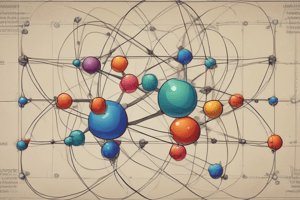Podcast
Questions and Answers
What is the atomic number of an element that has 6 protons?
What is the atomic number of an element that has 6 protons?
- 7
- 6 (correct)
- 5
- 8
In which of the following scenarios will an atom become more stable?
In which of the following scenarios will an atom become more stable?
- By gaining two electrons (correct)
- By maintaining an unfilled outer orbital
- By losing one electron
- By sharing electrons with another atom (correct)
What does the atomic weight of oxygen (16O) signify?
What does the atomic weight of oxygen (16O) signify?
- 16 protons and 8 neutrons
- 8 protons and 8 electrons
- 8 protons and 16 neutrons
- 8 protons and 8 neutrons (correct)
What is a characteristic common to all major classes of biomolecules?
What is a characteristic common to all major classes of biomolecules?
Which statement correctly describes a compound?
Which statement correctly describes a compound?
Which functional group characteristic contributes to the diversity of organic compounds?
Which functional group characteristic contributes to the diversity of organic compounds?
If an atom has a valence of 3, how many electrons does it need to gain or lose to fill its outer orbital?
If an atom has a valence of 3, how many electrons does it need to gain or lose to fill its outer orbital?
Which biomolecule is primarily responsible for storing and transmitting genetic information?
Which biomolecule is primarily responsible for storing and transmitting genetic information?
What is the molecular weight of water (H2O)?
What is the molecular weight of water (H2O)?
Which of the following statements about polyfunctional biomolecules is true?
Which of the following statements about polyfunctional biomolecules is true?
Which characteristic of electrons is key in chemical bonding?
Which characteristic of electrons is key in chemical bonding?
Which combination of amino acids is not listed as derivatives of arginine?
Which combination of amino acids is not listed as derivatives of arginine?
Which element has a greater atomic weight than that of nitrogen, which has an atomic weight of 14?
Which element has a greater atomic weight than that of nitrogen, which has an atomic weight of 14?
What role do lipids primarily play in biomolecular structure?
What role do lipids primarily play in biomolecular structure?
Why do most atoms tend toward bonding with other atoms?
Why do most atoms tend toward bonding with other atoms?
What is the approximate strength of hydrogen bonds compared to covalent O-H bonds in water?
What is the approximate strength of hydrogen bonds compared to covalent O-H bonds in water?
Which of the following statements about hydrogen bonds is false?
Which of the following statements about hydrogen bonds is false?
Which function of hydrogen bonds is NOT correctly associated with its role?
Which function of hydrogen bonds is NOT correctly associated with its role?
What is a characteristic of the elements essential to life?
What is a characteristic of the elements essential to life?
Which of the following elements is NOT typically classified as essential for organic matter?
Which of the following elements is NOT typically classified as essential for organic matter?
How many naturally occurring chemical elements are considered essential to organisms?
How many naturally occurring chemical elements are considered essential to organisms?
Which statement accurately describes the interaction between biomolecules?
Which statement accurately describes the interaction between biomolecules?
What role do hydrogen bonds play in cellular membranes?
What role do hydrogen bonds play in cellular membranes?
Which of the following is NOT a notable fact about water's hydrogen bonds?
Which of the following is NOT a notable fact about water's hydrogen bonds?
Which statement about the fitness of organic compounds is incorrect?
Which statement about the fitness of organic compounds is incorrect?
Which of the following ions represents a cation?
Which of the following ions represents a cation?
What is the role of iron ions in the hemoglobin molecule?
What is the role of iron ions in the hemoglobin molecule?
Which of the following trace elements is not essential to the function of specific proteins?
Which of the following trace elements is not essential to the function of specific proteins?
Which of the following elements forms the most bonds due to needing four electrons?
Which of the following elements forms the most bonds due to needing four electrons?
Which of the following is a characteristic of the lightest elements in biological systems?
Which of the following is a characteristic of the lightest elements in biological systems?
Which trace element is represented by the chemical symbol 'Cu'?
Which trace element is represented by the chemical symbol 'Cu'?
What percentage of the total mass of most cells is made up of the four most abundant elements?
What percentage of the total mass of most cells is made up of the four most abundant elements?
Which of the following trace elements represents the highest percentage of total body weight?
Which of the following trace elements represents the highest percentage of total body weight?
What is the function of covalent bonds formed by the lightest elements?
What is the function of covalent bonds formed by the lightest elements?
Which of the following elements requires two electrons to achieve stability?
Which of the following elements requires two electrons to achieve stability?
What is the fundamental process that leads to the formation of ionic bonds?
What is the fundamental process that leads to the formation of ionic bonds?
Which type of atom becomes negatively charged during ionic bond formation?
Which type of atom becomes negatively charged during ionic bond formation?
What is the key characteristic of hydrogen bonds compared to ionic bonds?
What is the key characteristic of hydrogen bonds compared to ionic bonds?
In the context of ionic bonds, what indicates the charge of an ion?
In the context of ionic bonds, what indicates the charge of an ion?
What allows water molecules to form hydrogen bonds with each other?
What allows water molecules to form hydrogen bonds with each other?
What type of charge does a cation carry?
What type of charge does a cation carry?
At what temperature are ionic bonds typically readily broken?
At what temperature are ionic bonds typically readily broken?
Which of the following statements about hydrogen bonds is true?
Which of the following statements about hydrogen bonds is true?
The bond formed by the attraction of a positively charged atom to a negatively charged atom is called what?
The bond formed by the attraction of a positively charged atom to a negatively charged atom is called what?
Why are ionic bonds considered common among weak forces?
Why are ionic bonds considered common among weak forces?
Flashcards are hidden until you start studying
Study Notes
Elements and Atoms
- An element is a substance composed of a single type of atom.
- Atomic number indicates the number of protons in an atom, which equals the number of electrons.
- Example: Hydrogen has 1 proton (atomic number 1); Oxygen has 8 protons (atomic number 8).
- Atomic weight (mass) is the sum of protons and neutrons; electrons do not contribute significantly to weight.
- Examples: Hydrogen has an atomic weight of 1 (1 proton, no neutrons); Oxygen has an atomic weight of 16 (8 protons, 8 neutrons).
Chemical Bonds and Molecule Formation
- Atoms seek to fill their outer orbitals for maximum stability.
- Unfilled orbitals lead to bonding with other atoms for stability.
- Valence refers to the number of electrons an atom must gain or lose to fill its outer orbital.
- A compound contains two or more different elements.
- Molecular weight of a compound is the total of the atomic weights of its constituent atoms; water's molecular weight is 18.
Ionic Bonds
- Ionic bonds form by strong attraction between ions after electron transfer.
- Atoms can gain (become anions) or lose (become cations) electrons, leading to charged ions.
- Superscript numbers indicate the difference between protons and electrons in ions.
- Ionic bonds are commonly weak, easily broken at room temperature.
Hydrogen Bonds
- Hydrogen bonds are weak attractions between a positively charged hydrogen atom in one polar molecule and a negatively charged atom in another (often O or N).
- Water can form hydrogen bonds with multiple molecules, resulting in a fluid structure with approximately four hydrogen bonds per molecule.
- Although weak individually, numerous hydrogen bonds can provide significant structural integrity.
- Hydrogen bonds stabilize 3D molecular structures and are crucial in enzyme activity.
Biomolecules
- Biomolecules are products of evolutionary selection, optimized for biological functions and interactions.
- Approximately 30 of 90 naturally occurring elements are essential for life, with lower atomic numbers predominating.
- Oversights in essential dietary elements can affect various species differently.
Essential Elements in Nutrition
- Major elements include Carbon (C), Oxygen (O2), Sulfur (S), Hydrogen (H2), Nitrogen (N2), and Phosphorus (P).
- Important monoatomic ions: Sodium (Na+), Magnesium (Mg++), Chloride (Cl-), Potassium (K+), Calcium (Ca++).
- Trace elements (e.g., Mn, Co, Zn) are minimal but essential for specific protein functions.
Abundant Elements in Organisms
- Four primary elements (C, H, O, N) account for 99% of cellular mass.
- Light elements tend to form strong covalent bonds due to their ability to share electrons effectively.
- Functional groups modify molecules, allowing for various organic compound families.
Major Classes of Biomolecules
- Proteins function as gene products, catalysts (enzymes), and structural components.
- Nucleic acids are responsible for storing and transmitting genetic information.
- Polysaccharides provide energy storage and extracellular structural support.
- Lipids serve as energy storage and are vital structural components of membranes.
Speciation and Differentiation of Biomolecules
- Complex biomolecules evolve from simpler primordial forms.
- Key examples include variations of amino acids and nucleic acid components (e.g., derivatives of arginine, proline, leucine, guanine).
Studying That Suits You
Use AI to generate personalized quizzes and flashcards to suit your learning preferences.




